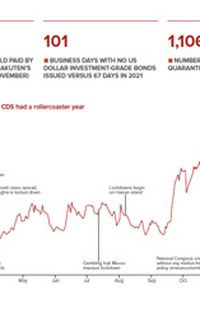As Japan makes the crucial move to net-zero carbon emissions and other environmental targets, it is relying on transition finance as the mechanism to get there.
![]()
Japan made waves in the green finance world with its announcement in May 2022 that it would issue ¥20trn (US$157bn) of bond instruments to finance its transition efforts. There was just a little hiccup with the yet-to-be-ratified grand plan: the financing instrument of choice is transition bonds.
This is a vaguely defined category of fixed-income instruments to help, as the name implies, companies move to renewable energy sources.
This softly-softly approach is perhaps not surprising, given that coal and natural gas still make up 68% of electricity generation in Japan, making the country one of the largest global economies still so heavily reliant on fossil fuels.
But the approach has led to criticism. Among those questioning Japan’s plan is the Asia Investor Group on Climate Change, which represents US$39trn in assets under management from investors across 11 Asian markets, with over 65 investor members. Anjali Viswamohanan, director for policy at AIGCC, said that Japan – and several other countries in Asia – are attempting to align sustainable finance frameworks with their national priorities rather than with recommended mitigation pathways to achieve the 1.5-degree target as recommended by credible bodies such as the Intergovernmental Panel on Climate Change.
“It is important that they aim to be credible structures that are aligned with international benchmarks to help ease investors’ decision-making process relating to climate investments,” Viswamohanan said.
ESG financing specialists worry that focusing on transition bonds will simply allow Japan too much wiggle room and that a genuine transition will be too slow.
There is, though, some pushback on the view that Japan is not taking green finance seriously.
“Japan does not focus only on transition finance instead of green finance,” said Sachie Ii, sustainability chief strategist at Mizuho. “Japan continues to emphasise green finance. On the other hand, high-emission companies often have low green assets. But that doesn’t mean that they’re not doing carbon-reduction activity. They’re actually doing it in a painstaking way. And while the target project’s [for transition finance deals] current emissions might be high in the transition period, after that the amount of reduction in the CO2 emission will be much higher.”
Japan certainly has some geopolitical cover for its stance. The November 2022 G20 meeting recognised “the need to take actions to enable transition finance to support orderly, just and affordable transitions towards a low-greenhouse gas emissions and climate-resilient economy,” according to a G20 joint statement.
Cornered market
With ¥150trn of combined private and public investment needed for Japan to become a carbon-neutral society, the government has doubled down on its strategy, planning to issue sovereign yen bonds as transition instruments rather than the more widely recognised format of green bonds.
The transition bond label has faced resistance elsewhere, and some deals already priced have raised concern because they financed gas projects instead of renewables.
Sustainable Fitch argued in a November 2022 report that the transition finance label is problematic due to the confusion around its applications.
Nneka Chike-Obi, head of Asia-Pacific ESG research at Sustainable Fitch, said in the report that, in the agency’s own research, the term “transition” refers to activities that reduce greenhouse gas emissions, particularly from hard-to-abate sectors, in alignment with the goals of the Paris Agreement.
Others, like the International Capital Market Association, have rejected the standalone use of the term, urging issuers to align with either a use-of-proceeds angle under the categories of green, social or sustainability bonds, or to issue sustainability-linked bonds tied to transition targets.
However they are defined, Japan has been the largest issuer of transition bonds. Indeed, all transition bonds issued in 2022 were from Japanese entities and were denominated in yen.
Issuers typically fall into one of the government-targeted sectors: utilities, shipping, steel, and oil and gas. Transition bonds made up 9% of all ESG-labelled debt issuance globally in the first three quarters of 2022.
Not likely
Appealing to investors beyond the local market will remain a challenge until better impact data is available for the technologies these deals are financing, which is not a likely outcome, especially since some of the outcomes will not be known until after the transition bonds mature.
“For some bonds, there is a mismatch between debt maturity and the transition timeline,” Chike-Obi noted in the report. “For example, the earliest bond matures in 2027, while the issuer’s [greenhouse gas] reduction targets are set in 2030 and 2050. This creates difficulties for investors trying to determine the relationship between purchasing the bond and supporting the company in achieving targets beyond its maturity.”
Mizuho’s Ii said that while definitions remain under discussion, that situation will improve over time.
“It is not surprising that some investors are not confident about investing in transition finance because it is still vaguely defined,” she said. “However, the Japanese government has taken the lead in providing a roadmap for each sector and supports Japanese companies’ transition plans. With or without the transition label, it’s hard to analyse how a company will improve its corporate value in the future.
“Yet carbon neutrality won’t happen unless transition projects are funded. So if there is a move to increase understanding of transition finance, or if we face an investment bottleneck, it needs to be discussed and resolved globally.”
Better labels
Chike-Obi said Japan should switch focus to the sustainability-linked financing umbrella, which ought to work well for transition financing given the overlap between the category’s targets and the characteristics of the bonds issued.
“Transition as a concept is not based solely on allocating capital to specific assets or activities; it is inherently tied to an improvement in environmental performance over time,” Chike-Obi noted in the report. “We maintain that the majority of issuers in hard-to-abate sectors seeking to raise transition-focused debt can do so under the sustainability-linked label.”
While it remains to be seen whether such a shift will occur, some Japanese corporates have set ambitious targets. Panasonic, for instance, has committed to having its entire energy supply come from renewables. The company joined the US-based Clean Energy Buyers Association, a group of companies committed to achieving a 90% carbon-free US electricity system by 2030, a parallel goal to the company’s plan to reach net zero for Scope 1 and 2 emissions by 2030.
And just as there is mounting pressure on Japanese companies – especially those operating in the west – to outline a path to net zero, so there is on Japan as a whole.
As it counts down to its 2050 deadline to get there, it will need to win over investors to finance the journey. It remains to be seen whether the focus on transition bonds – on which it will largely be going it alone – will do the job.
To see the digital version of this report, please click here
To purchase printed copies or a PDF, please email shahid.hamid@lseg.com
















